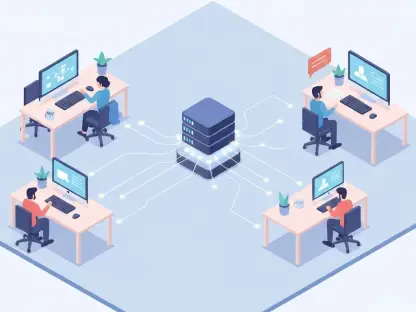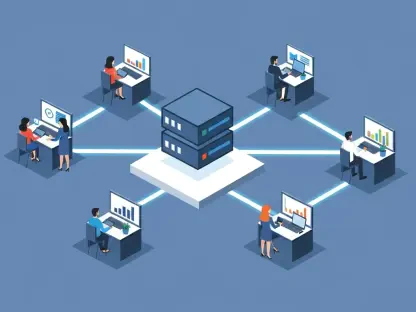In 2025, the FinTech sector stands at a pivotal moment, with Generative AI (GenAI) driving an unprecedented wave of transformation that promises to reshape the industry. A striking statistic from industry reports highlights that GenAI could unlock up to $340 billion in annual cost savings and productivity gains for global banking. This massive potential has captured the attention of technology leaders eager to integrate advanced AI into critical operations like fraud detection and customer onboarding. This market analysis delves into the current trends, data, and projections surrounding scalable GenAI architecture, exploring how it reshapes financial services and offering strategic insights for navigating this dynamic landscape.
Diving into Market Trends and GenAI Adoption
Current Landscape: GenAI as a Competitive Edge
The FinTech market is witnessing a surge in GenAI adoption as firms strive to outpace competitors through enhanced efficiency and innovation. Today, a significant portion of financial institutions leverage GenAI for automating repetitive tasks such as KYC verification and credit underwriting, reducing manual workloads by substantial margins. Tools like AWS Textract and Google Document AI are widely used to process complex financial documents, ensuring compliance with stringent regulations like GDPR. This trend reflects a broader shift toward data-driven decision-making, where real-time insights are no longer a luxury but a necessity for staying relevant in a fast-paced industry.
Data-Driven Insights: Quantifying the Impact
Market data underscores the transformative impact of GenAI, with operational cost reductions of 20-40% reported by early adopters in areas like customer service and risk assessment. Transaction processing times have plummeted from days to mere minutes, driven by fine-tuned large language models (LLMs) tailored for financial use cases. Additionally, customer satisfaction metrics show marked improvement due to personalized interactions powered by AI. These figures illustrate a clear correlation between GenAI integration and enhanced business outcomes, positioning it as a cornerstone of modern FinTech strategies.
Sectoral Shifts: Where GenAI Makes the Biggest Waves
Different segments within FinTech are experiencing varied levels of GenAI impact, with digital banking and payment platforms leading the charge. These sectors benefit from real-time fraud alerts and seamless customer onboarding, directly addressing pain points like security and user experience. Meanwhile, investment and trading platforms are increasingly relying on AI for market sentiment analysis and portfolio optimization, enabling more informed decision-making. This uneven adoption highlights the need for tailored architectures that cater to specific operational demands across the industry.
Projections: The Future Trajectory of GenAI in FinTech
Scaling Up: Adoption Rates and Market Expansion
Looking ahead, projections indicate that over 60% of FinTech workflows will incorporate GenAI within the next two years, from 2025 to 2027, driven by competitive pressures and evolving customer expectations. The focus will likely shift toward hybrid architectures that combine cloud and on-premises solutions to balance scalability with data security. Smaller, cost-effective LLMs are also expected to gain prominence, making advanced AI accessible to mid-sized firms previously constrained by resource limitations. This democratization of technology promises to level the playing field significantly.
Regulatory Evolution: Navigating Compliance Challenges
As GenAI adoption accelerates, regulatory bodies are anticipated to tighten guidelines around transparency and accountability in financial AI applications. Agencies like the SEC and FINRA are poised to introduce frameworks that mandate detailed audit trails and explainable outputs, ensuring fairness in automated decisions. FinTech companies will need to invest in architectures with robust guardrails and human-in-the-loop oversight to align with these evolving standards. Failure to adapt could result in substantial penalties or loss of consumer trust, making compliance a top priority.
Technological Advancements: Efficiency and Innovation on the Horizon
Emerging advancements in model efficiency and orchestration frameworks like LangChain are set to redefine how GenAI operates within FinTech ecosystems. These innovations will enable more precise coordination of complex workflows, such as dynamic model routing based on task sensitivity and latency requirements. Furthermore, the integration of Retrieval Augmented Generation (RAG) systems with vector databases will enhance contextual accuracy in areas like regulatory reporting. Such developments signal a future where GenAI not only boosts efficiency but also drives groundbreaking service offerings.
Reflecting on the Path Forward
Looking back, this analysis reveals how deeply GenAI has penetrated the FinTech sector by 2025, with measurable gains in cost efficiency and customer engagement shaping market dynamics. The projections underscore a trajectory of rapid adoption tempered by regulatory and technological challenges. For industry leaders, the next steps involve prioritizing modular architectures that can adapt to new models and compliance demands. Investing in human oversight mechanisms proves essential to maintain trust in automated systems. Ultimately, the journey highlights that strategic integration of GenAI is not just an option but a critical driver for sustained growth and resilience in an ever-evolving financial landscape.









